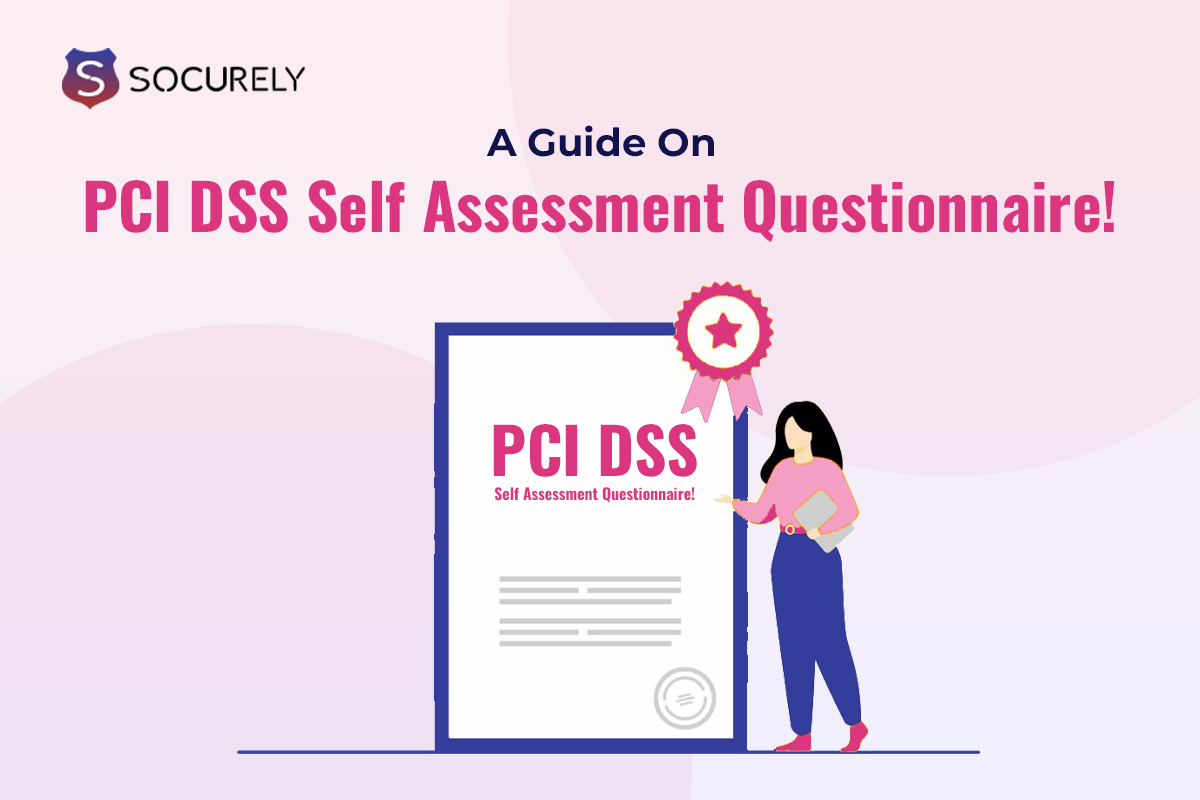Are you aware of how secure your payment processing systems are? With the increasing number of cyber-attacks targeting financial data, ensuring the security of payment card information is more critical than ever. In 2025, approximately $10.5 trillion in cybercrime damages are forecast to be incurred. For businesses handling card payments, compliance with the Payment Card Industry Data Security Standard (PCI DSS) is essential. A crucial part of this compliance journey is the PCI DSS Self-Assessment Questionnaire (SAQ).
In this comprehensive guide, we’ll explore everything related to the PCI DSS Self-Assessment Questionnaire, what it includes, the requirements, and how to choose the best one for your business.
Understanding PCI DSS Compliance and the Self-Assessment Questionnaire
To ensure corporate security, PCI DSS compliance requires the acceptance, processing, and storage of credit card information in a secure environment. It was established by the Payment Card Industry Security Standards Council (PCI SSC) to protect cardholder data and reduce credit card fraud.
The PCI DSS standards encompass a wide range of security measures, including network security, data encryption, access control, and regular monitoring and testing of security systems. Achieving PCI DSS compliance not only helps protect sensitive payment information but also enhances customer trust and reduces the risk of data breaches.
On the other hand, the PCI DSS Self-Assessment Questionnaire (SAQ) is a tool provided by the PCI Security Standards Council to help merchants and service providers evaluate their compliance with PCI DSS. It consists of a series of questions that correspond to the PCI DSS requirements. The goal of the SAQ is to provide a self-evaluation method for organizations that do not require a formal assessment by a Qualified Security Assessor (QSA).
The SAQ is divided into several versions, each tailored to different types of merchants and service providers based on their card transaction processes and the environment in which they operate. By accurately completing the SAQ, businesses can identify areas where they need to improve their security measures to comply with PCI DSS.
Why do you need a PCI DSS Self-Assessment Questionnaire?
Compliance with PCI DSS is not just about meeting regulatory requirements; it’s about protecting your customers’ sensitive payment card information. Here are some key reasons why you need a PCI DSS Self-Assessment Questionnaire:
- Security Enhancement: The SAQ helps identify vulnerabilities in your payment processing environment, allowing you to address them proactively.
- Regulatory Compliance: PCI DSS compliance is mandatory for all businesses that handle card payments. The SAQ ensures you meet these requirements, avoiding potential fines and penalties.
- Customer Trust: Demonstrating PCI DSS compliance builds trust with your customers, showing that you take their data security seriously.
- Risk Management: By identifying and mitigating security risks, the SAQ helps protect your business from data breaches and associated financial losses.
What Is Included in the PCI DSS Self-Assessment Questionnaire?
The PCI DSS Self-Assessment Questionnaire is divided into multiple sections, each addressing different aspects of the PCI DSS requirements. What it includes is as follows:
Business Information: This section gathers basic details about your business, providing an overview of your operations concerning payment card processing. Information required includes:
- Type of Merchant: Identifies whether you are a brick-and-mortar, e-commerce, or mail/telephone order merchant.
- Payment Channels: Specifies the methods through which you accept payment cards (e.g., in-store, online, mobile).
- Transaction Volumes: Reports the number of card transactions processed over a given period, helping to assess the scale of your operations.
Security Policies: In this section, the questionnaire probes into your organization’s security policies and procedures. Key aspects include:
- Policy Documentation: Ensures that you have documented security policies.
- Policy Review and Updates: Evaluate how frequently your security policies are reviewed and updated.
- Employee Training: Assesses whether employees are regularly trained on security policies and aware of their roles in maintaining security.
Access Control: This section evaluates how access to cardholder data is managed and restricted within your organization. It covers:
- User Authentication: Verifies that users are authenticated before accessing systems containing cardholder data.
- Access Privileges: Ensures that access to cardholder data is restricted based on business need-to-know.
- Role-Based Access: Confirms that access permissions are assigned based on users’ job responsibilities.
Data Encryption: Data encryption is a critical component of cardholder data protection. This section assesses the methods used to encrypt data during transmission and storage:
- Encryption Algorithms: Ensures that industry-standard encryption algorithms are used.
- Encryption Key Management: Evaluates procedures for managing and protecting encryption keys.
- Transmission Encryption: Confirms that cardholder data is encrypted during transmission over public networks.
Network Security: Network security measures are vital for protecting your systems from unauthorized access. This section includes questions on:
- Firewall Configuration: Checks if firewalls are installed and configured to restrict traffic to sensitive areas.
- Network Segmentation: Assesses whether your network is segmented to limit access to cardholder data.
- Secure Configuration Standards: Verifies that systems are securely configured according to best practices.
Vulnerability Management: Effective vulnerability management is essential for identifying and addressing security weaknesses. This section evaluates your processes for:
- Regular Scans: Ensures that vulnerability scans are conducted regularly on all systems.
- Patch Management: Confirms that security patches are applied promptly to address known vulnerabilities.
- Penetration Testing: Assesses whether regular penetration tests are conducted to identify and fix security gaps.
Physical Security: Physical security controls protect cardholder data from unauthorized physical access. This section covers:
- Secure Access: Ensures that physical access to systems storing cardholder data is restricted.
- Monitoring and Surveillance: Evaluate the use of security cameras and monitoring systems.
- Environmental Controls: Checks for controls to protect against environmental hazards such as fire and water damage.
Monitoring and Testing: Ongoing monitoring and testing of security systems are crucial for maintaining security. This section includes:
- Log Management: Ensures that logs of access to cardholder data are maintained and reviewed.
- Intrusion Detection Systems: Evaluate the deployment of systems to detect and respond to security incidents.
- Regular Testing: Confirms that security controls are tested regularly to ensure their effectiveness.
Incident Response: Preparedness for security incidents involving cardholder data is assessed in this section, including:
- Incident Response Plan: Ensures that a documented incident response plan is in place.
- Incident Handling Procedures: Evaluate procedures for responding to and mitigating security incidents.
- Notification Protocols: Confirms that protocols exist for notifying relevant parties, including customers and authorities, in the event of a data breach.
How does the PCI Self-Assessment work?
The PCI DSS Self-Assessment Questionnaire includes specific requirements that organizations must meet to achieve compliance. These requirements are based on the twelve PCI DSS core security standards:
- Ensure that cardholder data is protected by installing and maintaining a firewall.
- It is not advisable to use the vendor settings for passwords and other security parameters.
- Protect stored cardholder data.
- Encrypt transmission of cardholder data across open, public networks.
- Use and regularly update anti-virus software or programs.
- Develop and maintain secure systems and applications.
- Ensure that only those who need to know about cardholder data can access it.
- Everybody who uses a computer should be given a distinct ID.
- Restrict physical access to cardholder data.
- Keep track of and keep an eye on every access to cardholder data and network resources.
- Test security procedures and systems regularly.
- Ensure that all staff members are covered by an information security policy.
Choose The Best PCI Compliance Self-Assessment questionnaire
Selecting the right PCI DSS Self-Assessment Questionnaire depends on your business type and how you process card transactions. Here are the main types of SAQs and their applicability:
- SAQ A: For e-commerce or mail/telephone-order merchants who outsource all cardholder data functions.
- SAQ A-EP: For e-commerce merchants who outsource their payment processing but have a website that does not receive cardholder data.
- SAQ B: For merchants using imprint machines or standalone, dial-out terminals.
- SAQ B-IP: For merchants using standalone, IP-connected terminals.
- SAQ C: For businesses that don’t keep cardholder data on file yet have payment systems that are online.
- SAQ C-VT: For merchants who use web-based virtual terminals.
- SAQ D: For merchants and service providers who do not fit into any of the above categories.
Choosing the correct SAQ ensures that your assessment accurately reflects your business operations and compliance requirements.
Get Help With Socurely
Navigating the complexities of PCI DSS Self-Assessment can be challenging, but you don’t have to do it alone. Socurely offers expert guidance and support to help you complete your SAQ with confidence. We help you with the following::
- Identify the appropriate SAQ for your business.
- Conduct a thorough gap analysis to pinpoint areas needing improvement.
- Assist with implementing necessary security controls.
- Make sure your crew receives regular training and assistance.
With Socurely, achieving PCI DSS compliance is a seamless and efficient process. Contact us today to learn how we can help secure your payment processing environment.
FAQs
Q1: How long does a PCI assessment take?
The duration of a PCI assessment varies based on the size and complexity of your organization. In general, it may take a few weeks to many months to finish.
Q2: What is the first step in PCI DSS assessment?
The first step in a PCI DSS assessment is to determine your PCI DSS scope, which involves identifying all system components, people, and processes that handle or impact cardholder data.
Q3: What is the main purpose of PCI DSS compliance?
The main purpose of PCI DSS compliance is to ensure the secure handling of cardholder information and to protect against data breaches and fraud.







